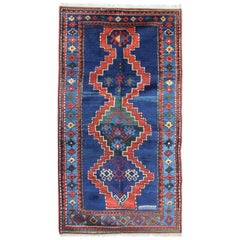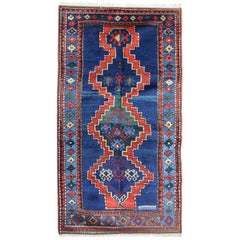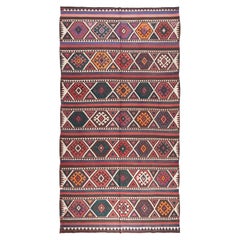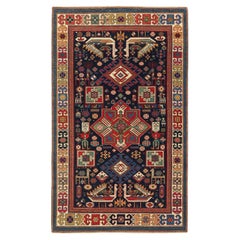Pars Rug Gallery Folk Art
to
2
2
1
1
1
2
2
2
2
2
2
2
2
2
2
Antique Rugs Blue Caucasian Kazak Rugs, Geometric Carpet Livingroom Rug
Located in Wembley, GB
Kazak rugs have primarily been produced as village productions rather than city pieces. Made from materials particular to individual tribal provinces and the rugs of the Caucasus typically display bold geometric designs in primary colours. Kazak rugs are a type of Armenian rug...
Category
Antique Late 19th Century Caucasian Kazak Caucasian Rugs
Materials
Natural Fiber, Organic Material, Wool
Antique Rugs Caucasian Kazak Rugs, Blue Geometric Hand made Carpet
Located in Wembley, GB
Kazak rugs have primarily been produced as village productions rather than city pieces. Made from materials particular to individual tribal provinces and the rugs of the Caucasus typ...
Category
Early 20th Century Caucasian Kazak Caucasian Rugs
Materials
Wool, Natural Fiber, Organic Material
Related Items
Vintage Shirvan Kilim Rug, Handwoven Caucasian Old Carpet
Located in Tokyo, JP
This is an old Shirvan Kilim from the Caucasus region with a rare and beautiful color composition.
Of the four countries that make up the Caucasus, Azerbaijan produces the most kilims, and the land has a long history of weaving. The nomadic tribes wove kilims and carpets as well as a wide range of storage bags and sacks, such as saffrash, khurgin and chula, and donkey and horse trappings. Smaller bags...
Category
Late 20th Century Caucasian Kilim Caucasian Rugs
Materials
Wool, Natural Fiber
Ararat Rugs Akstafa Kazak Rug - 19th C. Caucasian Revival Carpet Natural Dyed
By Ararat Rugs
Located in Tokyo, JP
Origin and Inspiration:
This stunning revival of the Akstafa Kazak Rug is a modern creation deeply rooted in the rich weaving traditions of the Caucasus, specifically inspired by the...
Category
21st Century and Contemporary Turkish Revival Caucasian Rugs
Materials
Wool, Natural Fiber, Organic Material
Antique Caucasus Soumak Kilim Sumac Rug, Caucasian Sumak Natural Carpet
Located in Tokyo, JP
This is an Antique Soumak ( Sumak, Sumac ) Kilim from the Caucasus region with a rare and beautiful color composition.
Of the four countries that make up the Caucasus, Azerbaijan produces the most kilims, and the land has a long history of weaving. The nomadic tribes wove kilims and carpets as well as a wide range of storage bags and sacks, such as saffrash, khurgin and chula, and donkey and horse trappings. Smaller bags for salt, utensils, and other items are also common. Not only are the Azerbaijani weavers prolific, but they also employ many techniques at the loom. These include slitweave- known locally by the word Kilim, warp-faced patterning (jajim), supplementary weft (zili), weft wrapping (popularly known as soumak), and extra weft wrapping (verneh). Furthermore, flatweaves are defined by regional names such as palas and shadda, so it is possible to ascribe a variety of weaving names to particular provenances as follows: soumaks are made in Kuba, palas, and kilims in Hajikabul, zili in Khizy, verneh and zili in Kazakh, shadda, verneh and zili in Barda, jajim in Agjabedi, and palas and kilims in Jabrail.
Soumak weave is a technique in which weft threads are added to a plain weave fabric, and one or two warp threads are wound from the front to the back. The resulting Kilim is denser and firmer, giving it a unique feel and look. This technique is commonly used in the Caucasus region.
Soumak kilims have a very beautiful contrast between orange that shines like the sun, deep purple-tinged indigo, and astringent dark red. You can also see the unevenly dyed abrage in this Soumak, which is like a magic carpet with an oriental atmosphere. Features of the Caucasian Kilim, such as the unique cosmic geometric floral pattern, are also found in this Soumak which has a bright look, but it also has a faded and textured feel, so it can be used in a good old atmosphere.
The woven fabric is particularly solid, so it is recommended for use in a solid living room or under a dining table without moving or twisting. A nice Kilim under a long wooden dining table.
Category
Antique Late 19th Century Caucasian Kilim Caucasian Rugs
Materials
Wool, Natural Fiber
Caucasus Kuba Fine Kilim Vintage Old Rug, Caucasian Natural Carpet
Located in Tokyo, JP
This is a Caucasian Old Kilim from the Kuba region with a red background and beautiful color composition.
Kilim of Kuba, a city in Azerbaijan. It is located by the Caspian Sea, ne...
Category
Mid-20th Century Caucasian Kilim Caucasian Rugs
Materials
Wool, Natural Fiber
Ararat Rugs Konagkend Kuba Rug, Antique Caucasian Revival Carpet, Natural Dyed
By Ararat Rugs
Located in Tokyo, JP
The source of the rug comes from the book Oriental Rugs Volume 1 Caucasian, Ian Bennett, Oriental Textile Press, Aberdeen 1993, nr.332. This is a sp...
Category
21st Century and Contemporary Turkish Revival Caucasian Rugs
Materials
Wool, Organic Material, Natural Fiber
W 85.83 in L 130.71 in
Ararat Rugs Akstafa Kazak Rug, 19th C. Caucasian Revival Carpet Natural Dyed
By Ararat Rugs
Located in Tokyo, JP
The design source of the rug comes from a private collection sold at a European auction. This rug is from the late 19th century, Kazak region, Caucasus area. The Akstafa design remin...
Category
21st Century and Contemporary Caucasian Revival Caucasian Rugs
Materials
Wool, Natural Fiber, Organic Material
Ararat Rugs Derbend Kazak Rug, 19th C. Caucasian Revival Carpet Natural Dyed
By Ararat Rugs
Located in Tokyo, JP
This is a Derbend Kazak rug also known as Daghestan rug, designed late 19th century, is a type of handwoven rug that originates from the Caucasus region, specifically from the town of Derbend (also spelled as Derbent) in modern-day Dagestan, Russia. Derbend rugs have a rich history that dates back centuries and are highly regarded for their intricate designs and craftsmanship. Derbend rugs are known for their bold and vibrant geometric designs. They often feature intricate patterns and motifs such as diamonds, medallions, stars, and stylized floral elements. The designs are typically woven with high contrast, using a variety of colors, including red, blue, green, and ivory. Derbend rugs have been woven by various ethnic groups in the Caucasus region, including the Azerbaijani, Lezgian, and Avar peoples. They hold cultural and historical importance as a form of artistic expression and are considered a part of the region's rich weaving heritage. The design of this rug is interpreted by our designers and soft colors are chosen for this rug.
Color summary: 7 colors in total;
Turquoise 330 (Spurge - Madder Root - Indigo - Walnut Husk)
Dark Brown 316 (No Dye - Sheep’s Own Color)
Barley Corn 103 (Only Specially Washed)
Mandarian Orange 529 (Madder Root - Walnut Hulsk)
Wax Flower...
Category
21st Century and Contemporary Caucasian Revival Caucasian Rugs
Materials
Wool, Natural Fiber, Organic Material
Vintage Old Kuba Super Fine Kilim Rug, Caucasian Carpet
Located in Tokyo, JP
This is a Caucasian Old Kilim from the Kuba (Quba) region in Azerbaijan, with a beautiful color composition.
Kuba is located near Tagestan, north of Azerbaijan, and is beside the Cas...
Category
Early 20th Century Caucasian Kilim Caucasian Rugs
Materials
Natural Fiber, Wool
Antique Caucasus Soumak Kilim Sumac Rug, Caucasian Natural Carpet
Located in Tokyo, JP
This is a large Antique Soumak ( Sumak, Sumac ) Kilim from the Caucasus region with a rare and beautiful color composition.
Of the four countries that make up the Caucasus, Azerbaijan produces the most kilims, and the land has a long history of weaving. The nomadic tribes wove kilims and carpets as well as a wide range of storage bags and sacks, such as saffrash, khurgin and chula, and donkey and horse trappings. Smaller bags for salt, utensils, and other items are also common. Not only are the Azerbaijani weavers prolific, but they also employ many techniques at the loom. These include slitweave- known locally by the word kilim, warp-faced patterning (jajim), supplementary weft (zili), weft wrapping (popularly known as soumak), and extra weft wrapping (verneh). Furthermore, flatweaves are defined by regional names such as palas and shadda, so it is possible to ascribe a variety of weaving names to particular provenances as follows: soumaks are made in Kuba, palas, and kilims in Hajikabul, zili in Khizy, verneh and zili in Kazakh, shadda, verneh and zili in Barda, jajim in Agjabedi, and palas and kilims in Jabrail.
Soumak weave is a technique in which new weft threads are added to a plain weave fabric, and one or two warp threads are wound from the front to the back. The resulting kilim is denser and firmer, giving it a unique feel and look. This technique is commonly used in the Caucasus region.
Soumak Kilims have a very beautiful contrast between orange that shines like the sun, deep purple-tinged indigo, and astringent dark red. You can also see the unevenly dyed abrage in this sumac, which is like a magic carpet with an oriental atmosphere.
Features of the Caucasian kilim, such as the unique cosmic geometric floral pattern, are also found in this Soumak. It has a bright look, but it also has a faded and textured feel, so it can be used in a good old atmosphere. The woven fabric is particularly solid, so it is recommended for use in a solid living room or under a dining table without moving or twisting. A nice kilim under a long wooden dining table.
Category
Early 20th Century Caucasian Kilim Caucasian Rugs
Materials
Wool, Natural Fiber
Antique Sewan Kazak Rug Sevan Caucasian Carpet Late-19th Century Caucasus
Located in Tokyo, JP
This is a rare antique Sewan Kazak Rug from the Sewan / Sevan region in the southwest Caucasia.
This is another handsome example of the “Sewan” Ka...
Category
Antique Late 19th Century Caucasian Oushak Caucasian Rugs
Materials
Wool, Natural Fiber, Organic Material
Antique Caucasian Runner Rug, Caucasus Carpet
Located in Tokyo, JP
This is an antique runner rug from the Caucasus region with a rare and beautiful color composition.
Of all the rugs of the oriental world, it is the work of the Caucasian weavers ...
Category
Early 20th Century Caucasian Oushak Caucasian Rugs
Materials
Wool, Natural Fiber
Old Caucasus Soumak Sumac Kilim Rug, Caucasian Natural Sumak Carpet
Located in Tokyo, JP
This is an old Soumak ( Sumak, Sumac ) Kilim from the Caucasus region with a rare and beautiful color composition.
Of the four countries that make up the Caucasus, Azerbaijan produces the most kilims, and the land has a long history of weaving. The nomadic tribes wove kilims and carpets as well as a wide range of storage bags and sacks, such as saffrash, khurgin and chula, and donkey and horse trappings. Smaller bags for salt, utensils, and other items are also common. Not only are the Azerbaijani weavers prolific, but they also employ many techniques at the loom. These include slitweave- known locally by the word kilim, warp-faced patterning (jajim), supplementary weft (zili), weft wrapping (popularly known as soumak), and extra weft wrapping (verneh). Furthermore, flatweaves are defined by regional names such as palas and shadda, so it is possible to ascribe a variety of weaving names to particular provenances as follows: soumaks are made in Kuba, palas, and kilims in Hajikabul, zili in Khizy, verneh and zili in Kazakh, shadda, verneh and zili in Barda, jajim in Agjabedi, and palas and kilims in Jabrail.
Soumak weave is a technique in which weft threads are added to a plain weave fabric, and one or two warp threads are wound from the front to the back. The resulting kilim is denser and firmer, giving it a unique feel and look. This technique is commonly used in the Caucasus region.
Soumak has a very beautiful contrast between orange that shines like the sun, deep purple-tinged indigo, and astringent dark red. You can also see the unevenly dyed abrage in this Soumak, which is like a magic carpet with an oriental atmosphere. Features of the Caucasian kilim, such as the unique cosmic geometric floral pattern, are also found in this Soumak which has a bright look, but it also has a faded and textured feel, so it can be used in a good old atmosphere.
The woven fabric is particularly solid, so it is recommended for use in a solid living room or under a dining table without moving or twisting. A nice kilim under a long wooden dining table.
Category
Mid-20th Century Caucasian Kilim Caucasian Rugs
Materials
Wool, Natural Fiber



